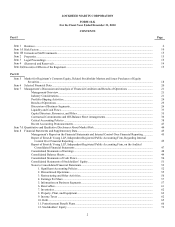Lockheed Martin 2010 Annual Report Download - page 18
Download and view the complete annual report
Please find page 18 of the 2010 Lockheed Martin annual report below. You can navigate through the pages in the report by either clicking on the pages listed below, or by using the keyword search tool below to find specific information within the annual report.10
Forward-Looking Statements
This Form 10-K contains statements that, to the extent they are not recitations of historical fact, constitute forward-looking
statements within the meaning of federal securities law. The words believe, estimate, anticipate, project, intend, expect, plan, outlook,
scheduled, forecast, and similar expressions are intended to help identify forward-looking statements.
Statements and assumptions with respect to future sales, income and cash flows, program performance, the outcome of
litigation, environmental remediation cost estimates, and planned acquisitions or dispositions of assets are examples of forward-
looking statements. Numerous factors, including potentially the risk factors described in the following section, could affect our
forward-looking statements and actual performance.
ITEM 1A. RISK FACTORS
An investment in our common stock or debt securities involves risks and uncertainties. We seek to identify, manage, and
mitigate risks to our business, but risk and uncertainty cannot be eliminated or necessarily predicted. You should consider the
following factors carefully, in addition to the other information contained in this Form 10-K, before deciding to purchase our
securities.
We depend heavily on U.S. Government contracts. A decline or reprioritization of funding in the U.S. defense budget, that of
other customers, or delays in the budget process could adversely affect our ability to grow or maintain our sales, earnings, and
cash flow.
We derived 84% of our sales from U.S. Government customers in 2010, including both defense and non-defense agencies. We
expect to continue to derive most of our sales from work performed under U.S. Government contracts. Those contracts are conditioned
upon the continuing availability of Congressional appropriations. Congress usually appropriates funds on a fiscal-year basis even
though contract performance may extend over many years.
The programs in which we participate must compete with other programs and policy imperatives for consideration during the
budget and appropriation process. Concerns about increased deficit spending, along with continued economic challenges, continue to
place pressure on U.S. and international customer budgets. While we believe that our programs are well aligned with national defense
and other priorities, shifts in domestic and international spending and tax policy, changes in security, defense, and intelligence
priorities, the affordability of our products and services, general economic conditions and developments, and other factors may affect
a decision to fund or the level of funding for existing or proposed programs.
Under such conditions, large or complex programs are potentially subject to increased scrutiny, particularly those programs that
have experienced performance challenges. Our largest program, the F-35 Lightning II Joint Strike Fighter program, represented 12%
of our sales in 2010, and is expected to represent a higher percentage of our sales in future years. The DoD completed a technical
baseline review of the System Development and Demonstration (SDD) portion of the F-35 program and made a recommendation to
the office of the Secretary of Defense to restructure the program to address cost and schedule risk. The restructuring was announced
by the Secretary of Defense on January 6, 2011 (see “Status of the F-35 Program” in Management’s Discussion and Analysis of
Financial Condition and Results of Operations on page 26 of this Form 10-K).
We offer a diverse range of defense, homeland security, and information technology products and services. We believe that this
makes it less likely that cuts in any specific contract or program will have a long-term effect on our business; however, termination of
multiple or large programs or contracts could adversely affect our business and future financial performance. We could incur expenses
beyond those that would be reimbursed if one or more of our existing contracts were terminated for convenience due to lack of
funding or other reasons. Potential changes in funding priorities may afford new or additional opportunities for our businesses in terms
of existing, follow-on, or replacement programs. While we would expect to compete, and be well positioned as the incumbent on
existing programs, we may not be successful, or the replacement programs may be funded at lower levels.
In years when the U.S. Government does not complete its budget process before the end of its fiscal year (September 30),
government operations typically are funded through a continuing resolution that authorizes agencies of the U.S. Government to
continue to operate, but does not authorize new spending initiatives. When the U.S. Government operates under a continuing
resolution, delays can occur in the procurement of products and services. The U.S. Government is currently operating under a
continuing resolution that is effective through March 4, 2011, and its budget for 2011 has not been finalized. This historically has not
had a material effect on our business; however, should the continuing resolution be prolonged further or extended through the entire
government fiscal year, it may cause procurement awards to shift and could cause our revenues to vary between periods from that
projected.
























